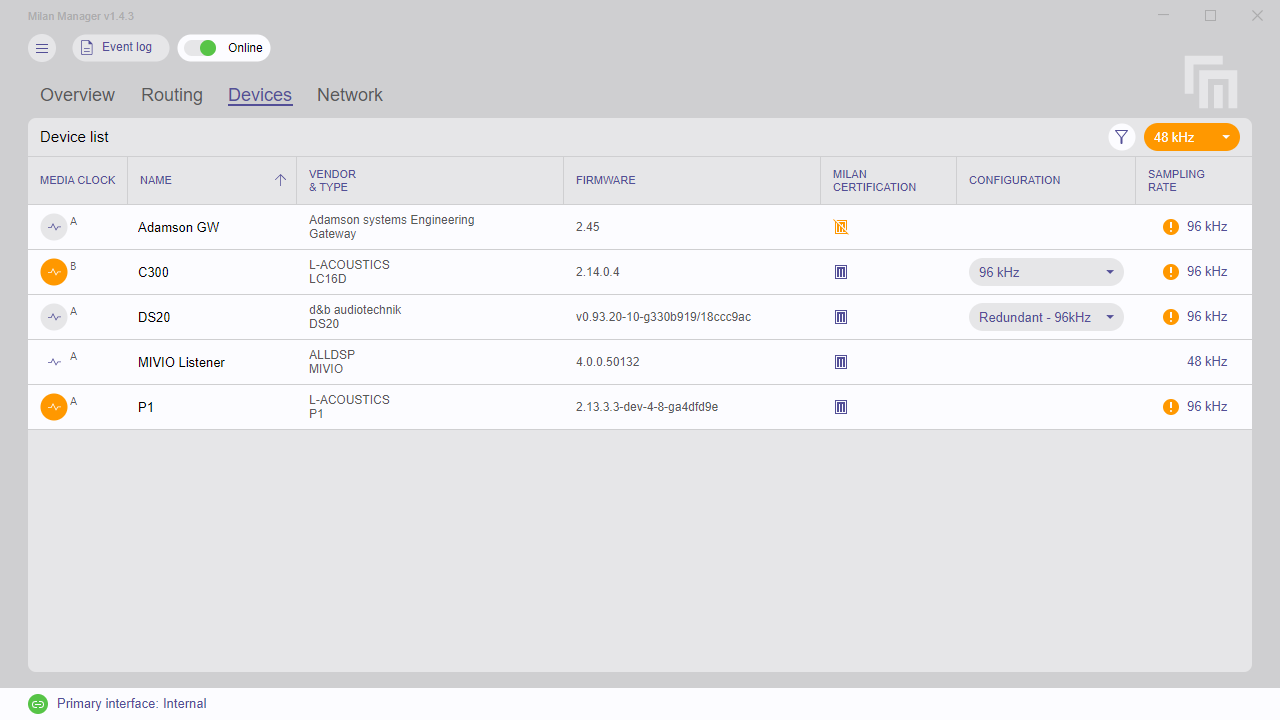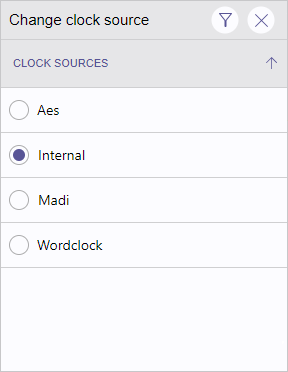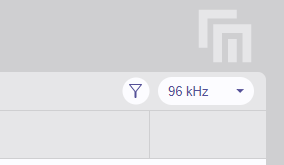Devices
The Devices tab provides detailed information about the devices in the network. It enables users to adjust the sampling rate, select device configurations, specify device names, and manage the Media Clock of the AVB domain.

Media Clock
The Media Clock of the AVB domain can be monitored and adjusted in the first column of the Devices tab. This column utilizes four icons to indicate the Media Clock status:
The device is designated as the Media Clock leader. |
|
The device serves as a Media Clock leader alongside other devices. Icons accompanied by the same character belong to the same Media Clock domain. |
|
The device can be selected to become the Media Clock leader. |
|
The device cannot be set as a Media Clock leader within a group. |
Some devices, while functioning as Media Clock leaders, allow users to choose from different clock sources to generate the Media Clock. To select a different clock source, left-click the icon of the current Media Clock leader. A popup will appear, listing possible clock sources. Left-click one of the icon-circles to choose a different clock source.

Device name
The device name can be edited by clicking on it.
Vendor & Type
This section displays the vendor and type of the device.
Firmware
This column shows the firmware version as reported by the device.
Milan certification
Milan certification is indicated using the following icons:
The device reports Milan certification. |
|
The device does not report Milan certification. |
Device configurations
Some devices offer multiple configurations, often used to implement different sampling rates (e.g., 48kHz, 96kHz) or Ethernet port configurations. If supported, a dropdown menu is displayed to choose a configuration. Changes are not applied directly. An additional dialog prompts for confirmation.
Sampling rate
The last column of the Devices tab displays the current sampling rate of each device.
Global sampling rate
A global sampling rate selection is provided in the upper right corner of the Devices tab, allowing adjustments to the sampling rate of all devices simultaneously.

The options for the global sampling rate selection are populated dynamically, listing all sampling rates (e.g., 44.1kHz, 88.2kHz, 96kHz, 176.4kHz and 192kHz) that occur at least once in one of the devices on the network. The default option '48kHz' is always available.
When changing the global sampling rate, Milan Manager attempts to adjust the sampling rate of all audio units and streams connected, regardless of the current device selection. However, some devices do not allow direct changes to the sampling rate of audio units. These devices will not be affected by the global change, and a dialog will appear listing all devices where changes are not applied.

If a device does not support direct sampling rate changes, it may be required to manually adjust the device configuration and reconnect all streams manually. An indication is provided if the device's sampling rate does not match the global selection.
In cases where a global sampling rate cannot be applied (e.g., when loading a network state with all devices using different sampling rates), the global sampling rate selection will display '– kHz'.
Device identify
Some devices implement an identify functionality to help locate the device. To invoke this feature, right-click the device row and choose 'Identify physical device (10s)'.

Firmware update
Milan Manager provides a generic approach for updating device firmware. To perform a firmware update, right-click the device row and choose 'Update Firmware'.

Afterwards, select a firmware file provided by the manufacturer for the update. Press 'Start' to initiate the firmware update. During the update, a progress indicator is displayed.

Please note that the device is rebooted after each update. If the device does not support the generic firmware update capability, 'not supported' will be displayed.

It is not possible to update multiple devices simultaneously.
Options
The following options are available at the top right corner of the Devices tab:
Display filtering options |